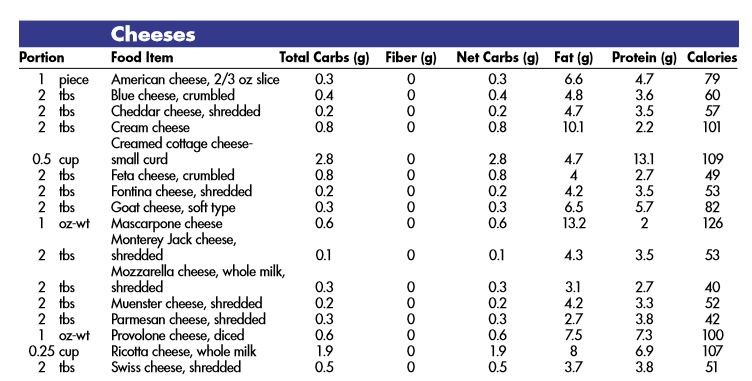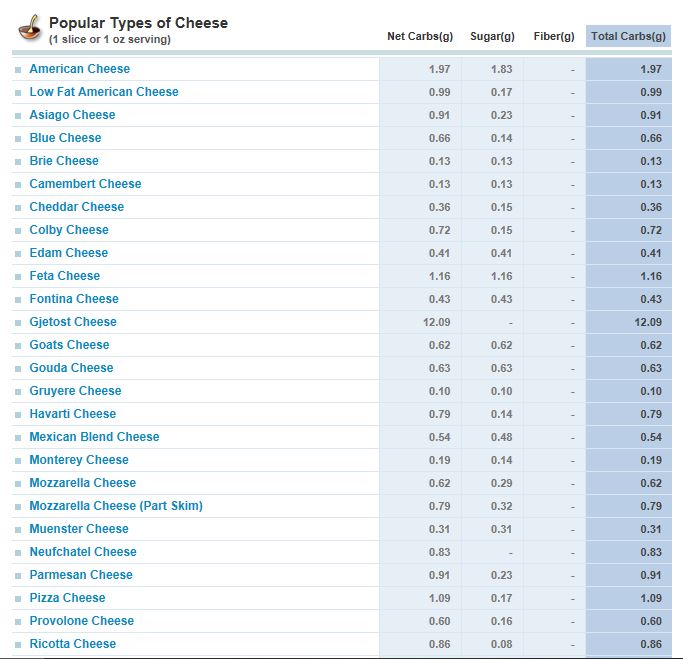Sugar vs. Total Carbohydrates on Labels
POINT #1
When reading nutrition labels, it’s often confusing, especially regarding sugar and total carbohydrates. I found this chart on Dr. Jeffry Gerber’s website:
https://denversdietdoctor.com/atkinscarbcounter.pdf
Notice that Total Carbs in cheese is the same as Net Carbs. Why? Because cheese doesn’t contain fiber. Fiber needs to be considered when looking at carbs on labels.
***
POINT #2
Total Carbohydrates
The carbohydrate count is given as total grams, and then broken down into carbs from fiber and sugar. Focus on total carbohydrate. Fiber is an important carbohydrate and should be included in your total for the day.
Net Carbohydrates
Net carbs = # of grams of total carbohydrates in a portion of food minus its grams of fiber. Because fiber is a carbohydrate that your body cannot digest, it does not raise your blood sugar levels or trigger an insulin response. The presence of fiber in the digestive tract also slows the absorption of any other carbohydrates, mitigating blood sugar spikes and insulin release.
Source: http://healthyeating.sfgate.com/difference-between-grams-carbohydrates-net-carbohydrates-2378.html
Example: If a food item has 20 grams of carbohydrates and it contains 8 grams of fiber, then the amount of net carbs the item contains is 12 grams.
***
POINT #3
Impact Vs Non-Impact Carbs
There are two types of carbs to consider here: impact carbs and non-impact carbs.
A) Impact Carbs
An impact carb is basically any carbohydrate type that has a high impact on your blood sugar level. These carbohydrate varieties are known as high GI (or high glycemic index) carbohydrates and they digest rapidly into the bloodstream.
When high GI carbs enter the bloodstream, unless they are immediately used for physical exercise, they typically contain more energy than the body can successfully “tap into” in one go. That means the excess carbs will simply get stored as body fat, opening the potential for negative health effects that obesity has to offer.
So basically, impact carbs are potentially very damaging to your health (and waistline) when consumed regularly in a completely unchecked manner. This is why you must ensure any food plan you follow has been structured correctly based on your specific body measurements. Otherwise, you run the risk of “spilling over” your maximum daily allowances for each nutrient group.
B) Non-Impact Carbs
Now, on the other hand, non-impact (or low-impact) carbohydrates are low GI and digest at a much slower rate within the bloodstream. Due to this prolonged release of energy, insulin spikes are unlikely and you’ll experience more sustained energy levels.
It’s the overconsumption of high GI carbohydrates that are presumed to cause many of the negative health conditions taking place today — hence, the rise of nutrition plans like the keto and Atkins diets. These plans help the body make the switch from being carb-dependent to being fat-dependent instead.
It’s specifically illnesses like type I and type II diabetes that are closely related to mass-produced, human-made carbohydrates. Therefore, we should all be a little more carb-conscious if we’re going to succeed in living a healthier lifestyle.
Making the switch from high GI to low GI (low-impact) carbs is certainly going to enhance your internal health and mental wellbeing long-term.
Source: https://www.perfectketo.com/what-are-net-carbs/
***
POINT #4
Look at this chart showing Net Carbs, Sugar, Fiber, Total Carbs for 1 oz. cheese. Notice how similar the numbers are in each category. Why? Cheese doesn’t contain fiber.
Source: https://www.fatsecret.com/calories-nutrition/food/cheese/carbohydrate
***
POINT #5
What is Lactose?
Lactose is the form of sugar that is found in milk and dairy products. It is a disaccharide, which means it is made up of two monosaccharides, or simple sugars. The monosaccharides that join to form lactose are glucose and galactose, both of which are important carbohydrates in the human body.
Breaking Down Lactose
Because disaccharides like lactose are relatively large molecules, they cannot be absorbed by the small intestine. Before lactose can be absorbed, it must be broken down into the smaller monosaccharides. In order to do this, the small intestine produces an enzyme called lactase. The job of lactase is to attach itself to the lactose molecule and hydrolyze it into glucose and galactose.
IMPORTANT: These smaller molecules can easily be absorbed by the intestines and enter the blood stream.
Source: http://healthyeating.sfgate.com/lactose-break-down-normal-individuals-9820.html
***

(PHOTO CREDIT: CAROLINE HOSTETTLER)
POINT #6
Since cheese contains no or very small amounts of sugar, it’s a good food for people who are concerned about their metabolic health, such as Type 2 diabetes and obesity. Unless sugar is added to dairy, such as in many yogurts—cheese, yogurt, and kefir are healthy foods, due to their good fat and protein content. Remember this: milk from grass-fed animals contains higher amounts of CLA and Omega-3 fats, which are associated with numerous health benefits for humans. (CLA: conjugated linoleic acids). Source: Healthy Cheese Lady

